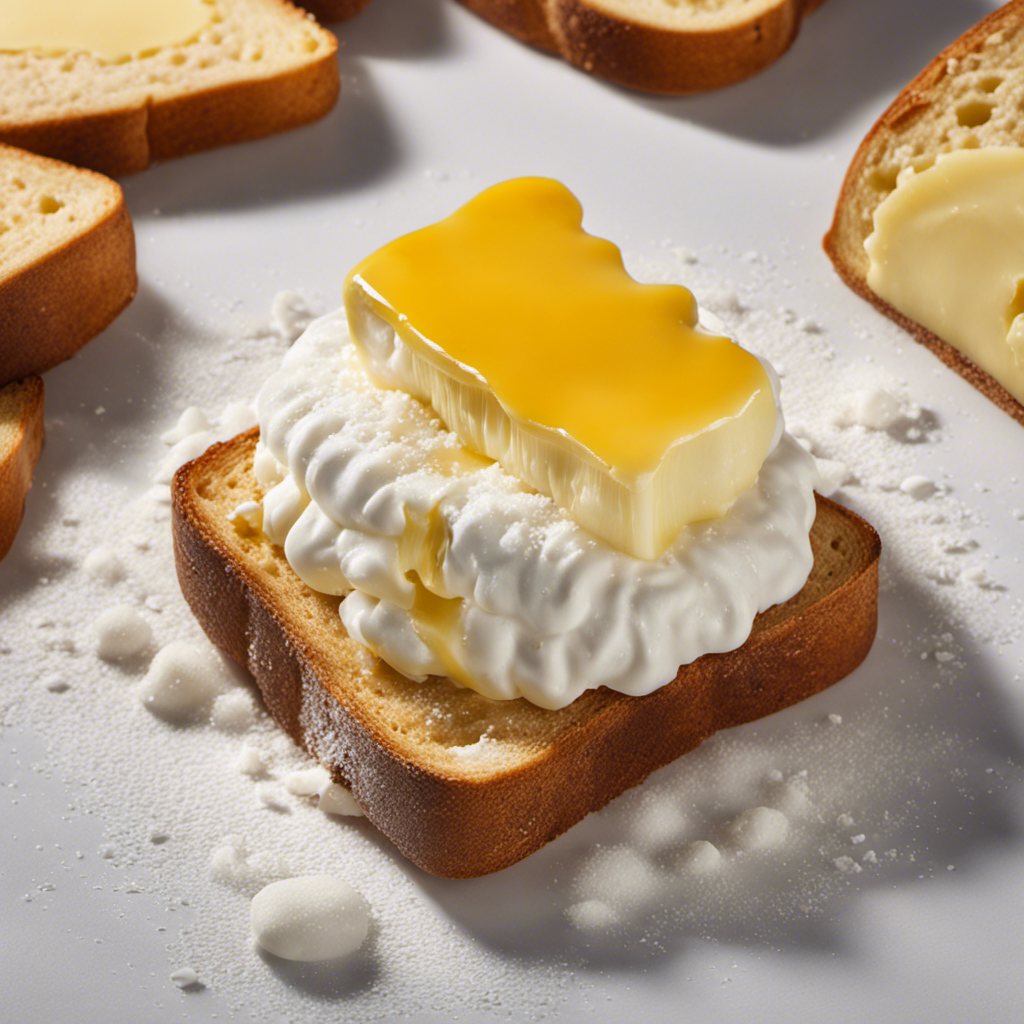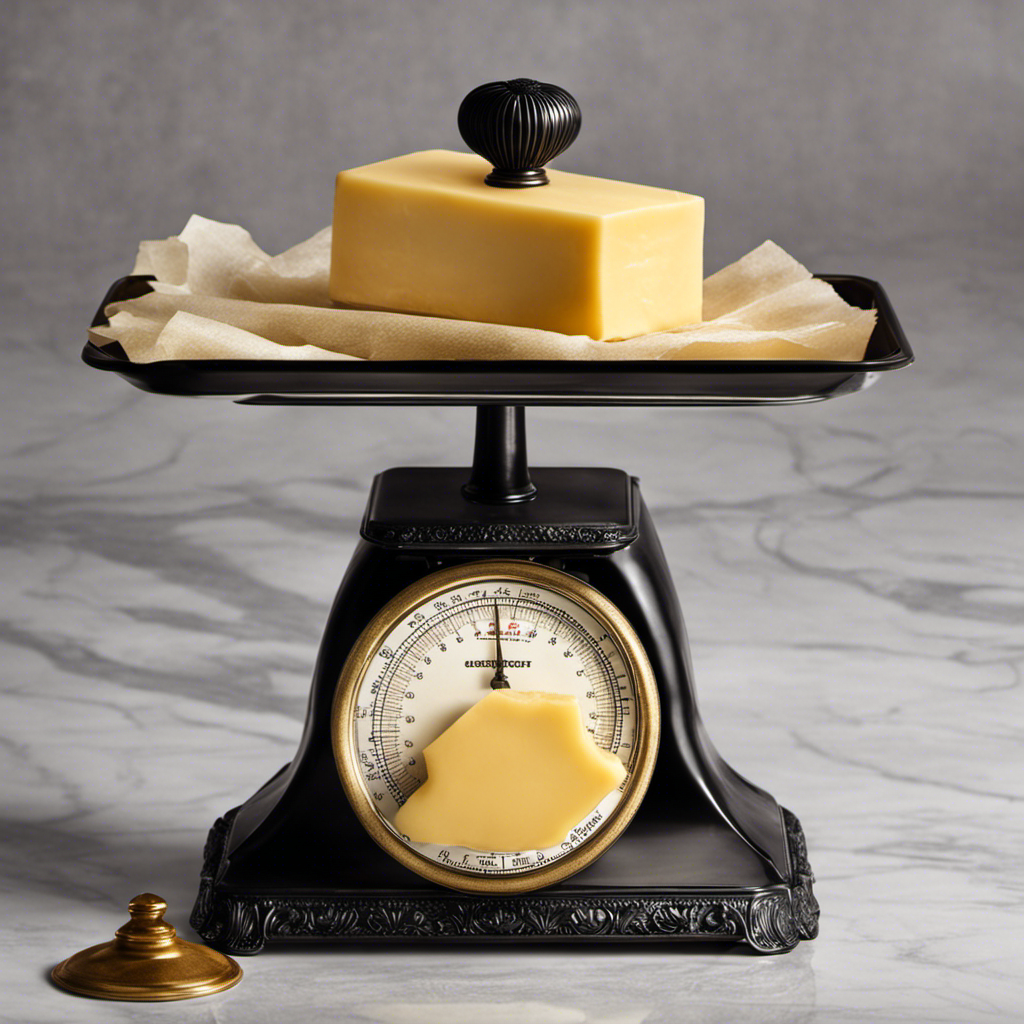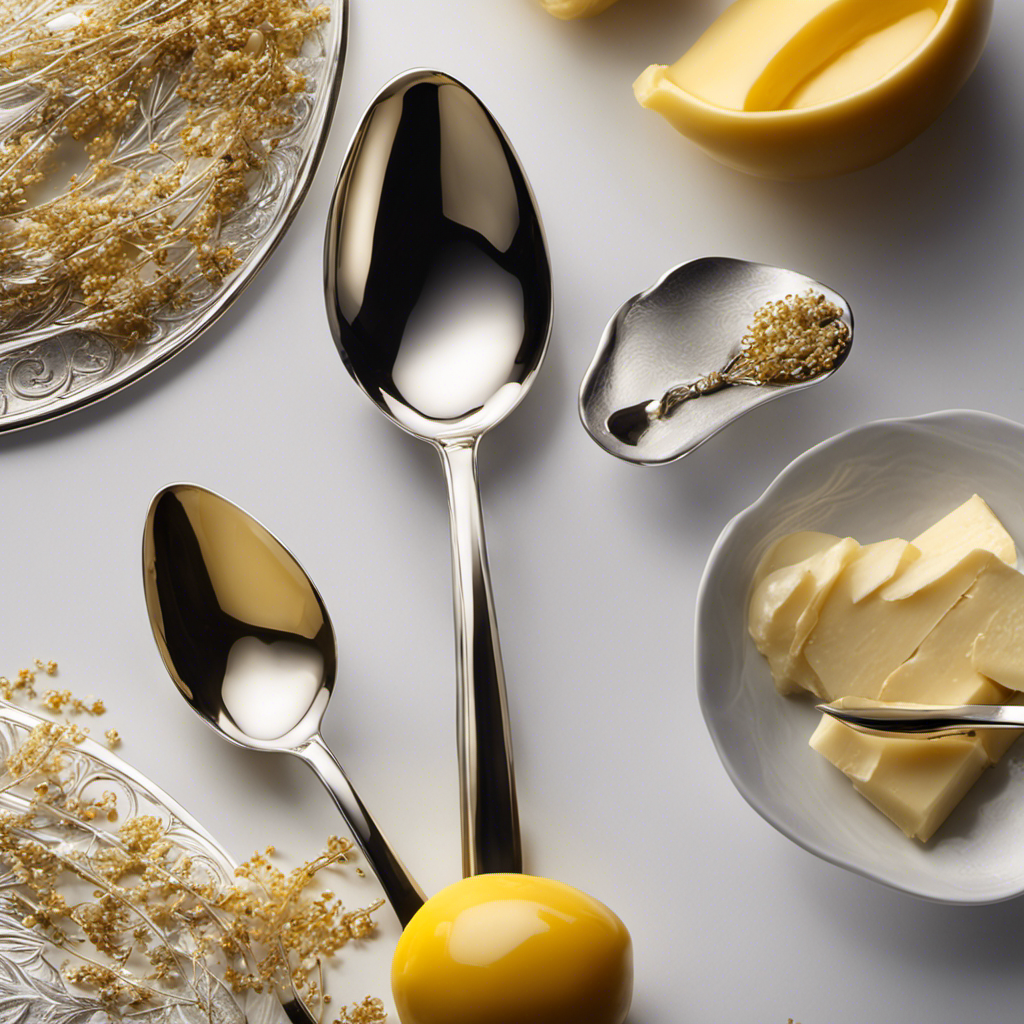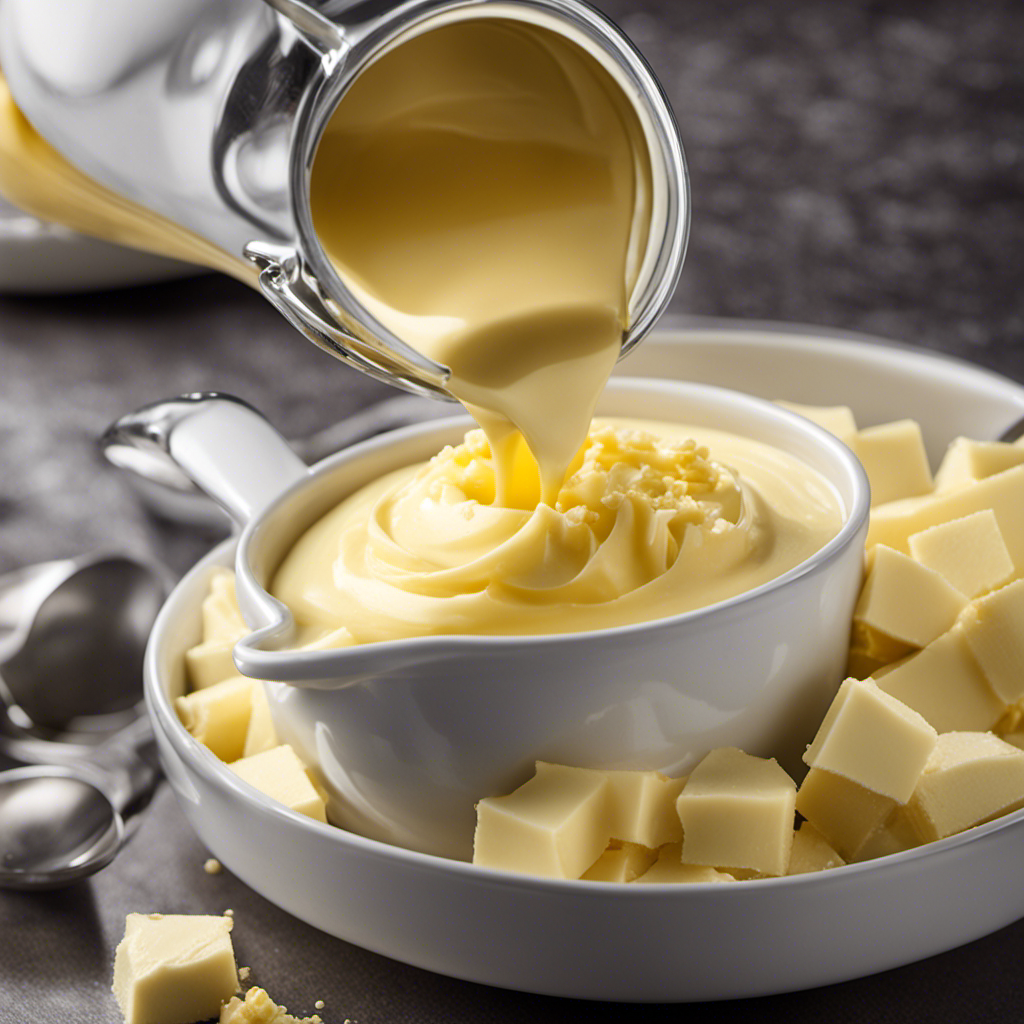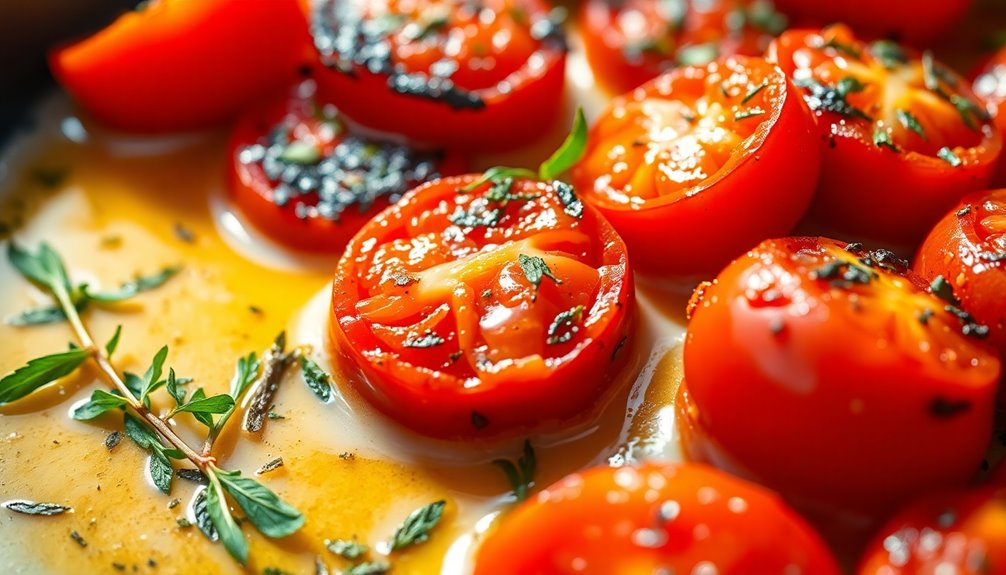As an inquisitive chef, I have frequently pondered the amount of salt present in a simple tablespoon of salted butter. In this article, we will explore the sodium levels in salted butter and reveal the nutritional composition hidden beneath its smooth exterior.
With a focus on portion control and a comparison to unsalted butter, we’ll explore how to reduce sodium intake while still enjoying the flavor of this beloved ingredient.
So, let’s grab our aprons and dive into the buttery world of sodium exploration.
Key Takeaways
- Salted butter contains approximately 90 milligrams of sodium per tablespoon, contributing to about 4% of the recommended daily sodium intake for adults.
- Excessive sodium intake from salted butter can lead to health problems like high blood pressure, heart disease, kidney stones, and osteoporosis.
- It is important to choose lower sodium options when possible to reduce health risks associated with excessive salt consumption.
- Low-sodium seasonings, low sodium spreads, and homemade flavored butter can be healthier alternatives to salted butter, allowing for reduced sodium intake without compromising flavor.
Understanding the Sodium Content in Salted Butter
You might be wondering how much sodium is in a tablespoon of salted butter. Well, let me tell you.
Salted butter contains about 90 milligrams of sodium per tablespoon. This may not seem like a lot, but when you consider the impact it can have on your daily sodium intake, it becomes significant.
The recommended daily intake of sodium for adults is around 2,300 milligrams, with some guidelines suggesting even lower amounts for individuals with certain health conditions. So, just a tablespoon of salted butter can contribute about 4% of your daily sodium intake.
It’s important to be mindful of your sodium consumption, as excessive sodium intake has been linked to high blood pressure and other health problems.
Analyzing the Nutritional Breakdown of Salted Butter
When it comes to salt content comparison, it’s important to understand the varying levels of sodium in different products. This is particularly crucial because excessive salt intake can have detrimental health implications, such as increased blood pressure and an increased risk of heart disease.
However, there are alternative low-salt options available that can still add flavor to our meals without compromising our health.
Salt Content Comparison
The salt content in a tablespoon of salted butter can vary depending on the brand. To give you an idea of the difference, I have created a comparison table below. It shows the salt content in three popular brands of salted butter.
| Brand | Salt Content (per tablespoon) |
|---|---|
| Brand A | 90mg |
| Brand B | 100mg |
| Brand C | 120mg |
As you can see, there is a noticeable variation in salt content between these brands. This information is important because excessive salt consumption can have negative health effects. High sodium intake has been linked to increased blood pressure, which can lead to heart disease and stroke. It can also contribute to the development of kidney stones and osteoporosis. It’s essential to be mindful of your salt intake and choose lower sodium options when possible.
Health Implications of Salt
Excessive salt consumption can have negative health effects, such as increased blood pressure and the development of kidney stones and osteoporosis. It is important to be aware of the health risks associated with consuming too much salt, as it can lead to serious health problems.
The recommended intake of salt for adults is no more than 2,300 milligrams per day, which is about one teaspoon. However, most people consume far more than this recommended amount.
The consequences of excessive salt intake include:
- Increased blood pressure, which can strain the heart and increase the risk of heart disease and stroke.
- Development of kidney stones, which can cause severe pain and discomfort.
- Osteoporosis, a condition characterized by weak and brittle bones.
It is crucial to monitor salt intake and make conscious choices to reduce consumption in order to maintain good health and prevent these potential health issues.
Alternative Low-Salt Options
One option for reducing salt intake is to use low-sodium seasonings and spices instead. This can help you cut down on your sodium intake without compromising on flavor.
When it comes to spreads and butters, there are alternatives available that are low in sodium. Instead of regular salted butter, you can opt for low sodium spreads or even make your own homemade flavored butter. These alternatives can help you cut down on your sodium intake without compromising on flavor.
Low sodium spreads are made with reduced or no added salt, making them a healthier choice. Homemade flavored butter allows you to control the ingredients and can be made with herbs, spices, and other seasonings to add flavor without relying on excessive salt.
The Importance of Portion Control With Salted Butter
Portion control is crucial when it comes to salted butter because consuming too much can have negative health effects. Here are three reasons why portion control is important when using salted butter:
-
Heart health: Excessive intake of salt can lead to high blood pressure, increasing the risk of heart disease and stroke.
-
Kidney function: Too much salt can strain the kidneys, potentially leading to kidney damage or disease.
-
Fluid retention: Consuming large amounts of salt can cause the body to retain water, leading to bloating and swelling.
By practicing portion control with salted butter, we can reap the benefits of its flavor while minimizing the health risks associated with excessive sodium intake.
Moderation is key in maintaining a healthy diet and preventing potential health complications.
Comparing Salted Butter to Unsalted Butter in Terms of Sodium Content
When comparing salted butter to unsalted butter, you can choose the option with less sodium content for a healthier choice. Sodium intake plays a crucial role in our overall health, as excessive consumption can lead to various health risks.
According to the USDA, a tablespoon of salted butter contains approximately 82 milligrams of sodium. On the other hand, unsalted butter has no added salt and therefore has a lower sodium content. By opting for unsalted butter, you can reduce your sodium intake and potentially lower the risk of high blood pressure, heart disease, and stroke.
It is important to note that while butter can be a delicious addition to meals, moderation is key to maintaining a balanced diet and minimizing health risks associated with excessive sodium consumption.
Tips for Reducing Sodium Intake While Using Salted Butter
To reduce sodium intake while using salted butter, it’s helpful to be mindful of other ingredients that may already contain high levels of sodium. Here are three tips for reducing sodium intake while still enjoying the flavor of salted butter:
-
Opt for low-sodium or unsalted versions of other ingredients, such as broths, sauces, and condiments. This can significantly reduce your overall sodium intake.
-
Use salted butter sparingly. Instead of slathering it on everything, try using it as a finishing touch or for added flavor in small amounts.
-
Explore healthier butter options. Look for spreads made from alternative sources like avocado or olive oil, which often have lower sodium content and can be just as delicious.
Exploring Healthier Alternatives to Salted Butter
When it comes to reducing sodium intake, exploring low-sodium butter options is a great place to start. These alternatives not only offer a lower sodium content, but they also provide nutritional benefits that can contribute to a healthier diet.
From avocado spread to Greek yogurt, there are a variety of flavorful butter replacements to choose from that can enhance the taste of your favorite dishes while still being mindful of your sodium intake.
Low-Sodium Butter Options
If you’re looking for low-sodium butter options, there are a few brands available on the market. These brands offer a great alternative to regular butter for individuals who are watching their sodium intake.
Here are some low sodium spread options to consider:
- Smart Balance Light: This brand contains only 55mg of sodium per serving, making it a good choice for those looking to reduce their sodium intake.
- Earth Balance Buttery Spread: With just 70mg of sodium per serving, this spread is a tasty option for those seeking a lower sodium alternative.
- Country Crock Plant Butter: This plant-based butter contains only 45mg of sodium per serving, making it a healthier choice for individuals looking to cut back on sodium.
Transitioning into the next section about the nutritional benefits of alternatives, it’s important to note that these low-sodium butter options not only offer reduced sodium content but also provide other beneficial nutrients that can contribute to a healthier diet.
Nutritional Benefits of Alternatives
Consider incorporating low-sodium butter alternatives into your diet for their nutritional benefits and healthier options. These alternatives are a great choice for those looking to reduce their sodium intake without sacrificing taste. Here are some low sodium spreads that can be used as alternatives to salted butter:
| Spread | Sodium (mg) | Calories (kcal) |
|---|---|---|
| Olive oil spread | 0 | 60 |
| Avocado spread | 0 | 80 |
| Almond butter | 0 | 90 |
| Coconut oil spread | 0 | 100 |
These spreads provide a delicious way to enhance the flavor of your food without adding excess sodium. They are also rich in healthy fats and other nutrients. So, why not give these low-sodium butter alternatives a try and enjoy all the nutritional benefits they have to offer? Your taste buds and your health will thank you!
Flavorful Butter Replacements
These low-sodium butter alternatives provide a tasty way to add flavor to your food without sacrificing health. When it comes to reducing sodium intake, choosing the right butter substitute can make all the difference. Here are some flavorful options to consider:
-
Olive oil: This heart-healthy option is rich in monounsaturated fats and adds a delicious, fruity taste to your dishes.
-
Avocado: With its creamy texture and mild flavor, mashed avocado can be a great substitute for butter in baking or spreading on toast.
-
Greek yogurt: Not only does it add a tangy taste, but Greek yogurt also provides a creamy consistency that works well in sauces and dressings.
Frequently Asked Questions
What Are the Health Risks Associated With Consuming Too Much Sodium From Salted Butter?
Consuming too much sodium from salted butter can have negative health effects, including increased blood pressure. It is important to be mindful of our sodium intake to maintain a healthy diet.
Can I Substitute Unsalted Butter for Salted Butter in a Recipe?
I can substitute unsalted butter for salted butter in a recipe by adjusting the amount of salt added. It’s important to consider the recipe’s overall flavor and balance when making this substitution.
How Does the Sodium Content in Salted Butter Compare to Other Common Condiments or Spreads?
The sodium content in salted butter can vary, but it is generally higher compared to other common condiments or spreads. Consuming too much sodium can have a negative impact on blood pressure.
Are There Any Specific Dietary Restrictions or Conditions That Should Be Considered When Consuming Salted Butter?
When consuming salted butter, it’s important to consider any dietary restrictions or health conditions. These factors can affect how much salt you should consume. Always consult with a healthcare professional for personalized advice.
What Are Some Tips for Reducing Sodium Intake While Still Enjoying the Flavor of Salted Butter in Cooking or Baking?
Reducing sodium intake can be achieved while still enjoying the flavor of salted butter. One tip is to use unsalted butter and add herbs or spices for flavor. Another option is to try alternative spreads, like avocado or nut butters.
Conclusion
In conclusion, after analyzing the nutritional breakdown of salted butter, it’s evident that there is a significant amount of sodium present in just a tablespoon.
However, by practicing portion control and being mindful of our sodium intake, we can still enjoy the delicious flavor of salted butter without compromising our health.
Additionally, exploring healthier alternatives to salted butter can be a great way to reduce sodium intake while still satisfying our taste buds.
Remember, a little bit of butter goes a long way!
